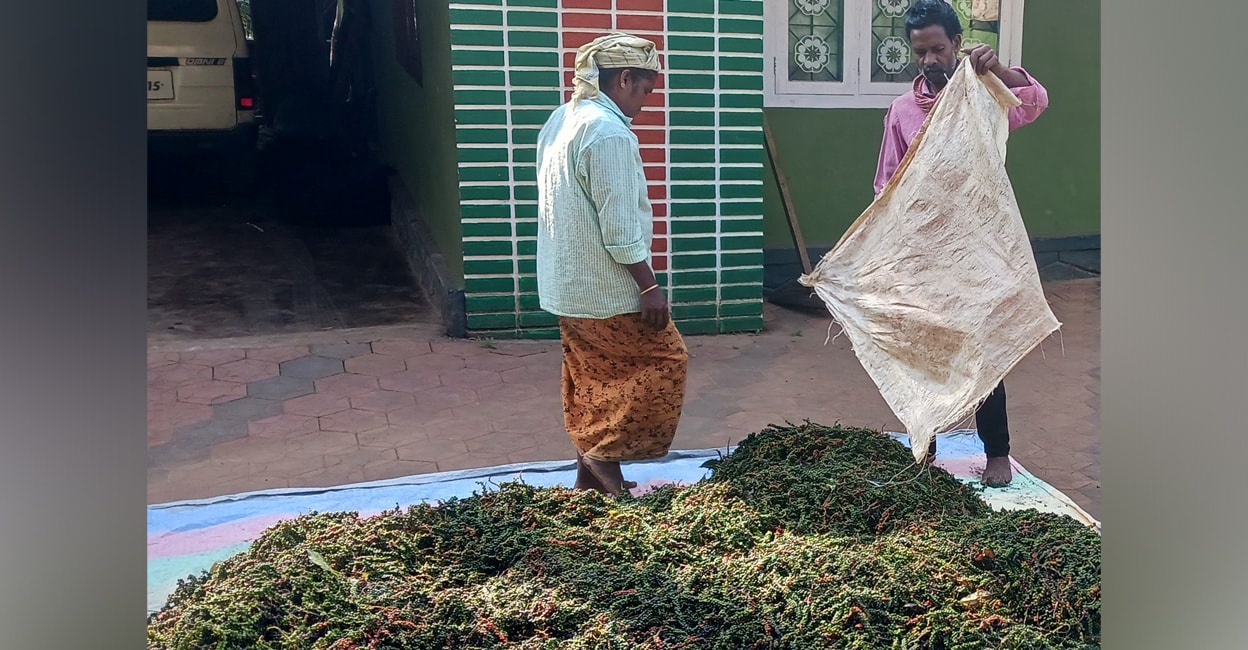Kalpetta: The ripple effect of a mercurial president’s decision to punish his country’s trading partners is being felt 17,000 km away in Wayanad. The sudden influx of Brazilian pepper through Sri Lanka has crashed prices in the domestic market, traders say.
Though Indian pepper markets are facing an acute shortage of farm-gate domestic pepper, with prices above ₹700/kg, the inflow of Brazilian pepper has brought market prices below ₹650/kg.
After the US President ratcheted up the tariff to 50 per cent, Brazil has been finding alternative markets for its produce. Moreover, India’s pepper exports to the US have also been hit by confusion over the 50 per cent additional tariff imposed on Indian products.
India cannot restrict imports from Sri Lanka as we have signed a free-trade agreement (FTA) with our neighbour. As per the deal, Sri Lanka can export up to 2,500 tonnes of pepper to India without any duty. In addition, under the South East Asian Free Trade Agreement (SAFTA), any quantity of pepper can be exported to India at a concessional customs duty of 8 per cent.
Dip in production
India’s pepper production has come down by 30-35 per cent this year. With festival and winter demand on the rise, traders and farmers were expecting an upswing in prices. But they have shown a downward trend.
During the week ending November 1, the price of pepper at the Kochi terminal dropped by ₹400 per quintal (100 kg), closing at ₹70,900 for garbled pepper and ₹68,900 for ungarbled pepper. In the previous week (ending on October 25), the prices were ₹71,300 and ₹69,300, respectively. Pepper arrivals for the week were just 172 tonnes, 52 tonnes fewer than the previous week.

A farmer with his pepper produce. Photo: Special arrangement
“Brazilian pepper, available for a much lower price than the Indian variety, is primarily responsible for the price drop in the domestic market,” said India Pepper and Spice Trading Association (IPSTA) Director Kishore Shamji.
Shamji told Onmanorama that the Brazilian pepper, priced at $6,000 per tonne in the international market, is routed to India via Sri Lanka to avail of the 8 per cent tax benefit. The landed price of 1 kg of pepper in New Delhi is around ₹530, and after adding expenses, it becomes available at ₹650, with importers taking about ₹100 per kg as profit. “Brazil is selling off old stock as the new harvest season begins,” he added.
“With exports to the US hit by the new tariff regime, Indian exporters are now exploring new destinations for exports,” Shamji said.
Hard to tell the difference
Traders in North India, the hub of pepper trade in the country, say that after the Trump tariffs, Brazilian pepper continues to flow into the country. It is available in the wholesale market for as low as ₹550 per kg.
According to Rajeev Sait, a trader in Delhi, the Brazilian pepper is as big as the Malabar pepper, making it difficult for ordinary consumers and traders to distinguish between the two. “Even experienced traders find it hard to differentiate between the premium Malabar pepper and the ‘smuggled’ Brazilian variety,” he told Onmanorama.

A farmer walking through his pepper field. Photo: Special arrangement
Importing for value addition
Traders’ forums have alleged that most of the pepper imported duty-free — if the CIF (Cost Insurance and Freight) value exceeds ₹500 — and meant for exporting after value-addition is being diverted to the domestic market. Many of these importers reportedly operate satellite EOUs (Export Oriented Units) to tap into the Indian market.
Farmers’ organisations have been demanding that the Spices Board of India make the import of licences mandatory. There is currently no effective monitoring system to ensure that imported pepper is actually used for the stated purpose and not diverted into the domestic market.
Interestingly, according to import-export data, India imported 40,000 tonnes of black pepper in 2024, of which 24,000 tonnes came from Sri Lanka. In comparison, imports from Sri Lanka were just 11,416 tonnes in 2022 and 14,000 tonnes in 2023.
Considering Sri Lanka’s total annual pepper production is around 25,000 tonnes, India is importing nearly the entire output.

